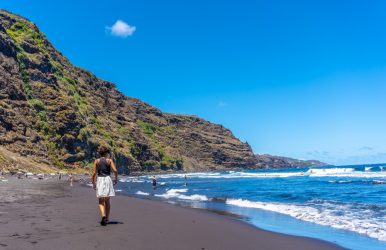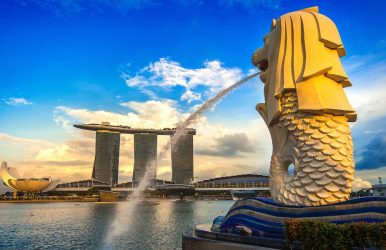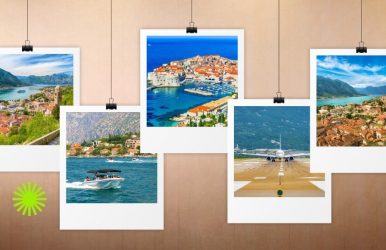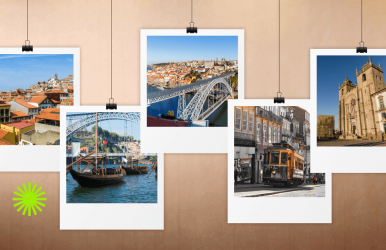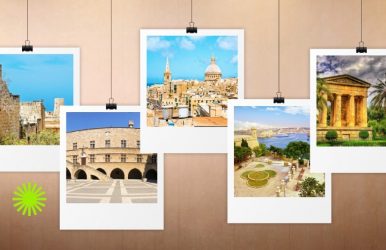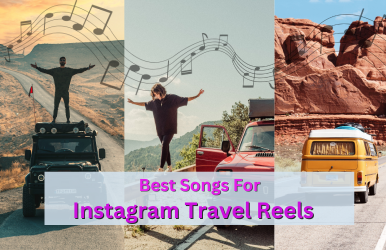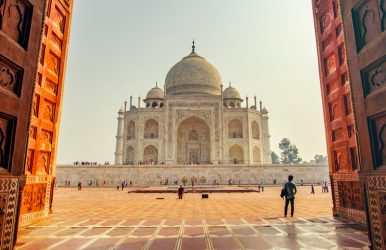What Are The Kotor Montenegro Transport Tips? How To Get Around Kotor, Montenegro On A Budget?
BY
Sibashree
Dec 12, 2025
Kotor, Montenegro, is emerging as an underrated gem for young professionals, digital nomads, people on the autism spectrum, and budget travelers.
In this article on Kotor Montenegro transport tips, you will know about the modes of transport, such as the Blue Line Buses, water taxis, and private transfers. Also, nobody says how reliable the Blue Line Bus Service is, or that the water taxi is not available for regular commuting.
Here, I will share my travel experiences and the secrets no one spills about getting around Kotor on a budget.
Kotor is very walkable, and that is one of the reasons why it is a paradise for backpackers and budget travelers. Furthermore, there is the Blue Line Bus, making your transport in and around the city more affordable.
However, during my Kotor Montenegro budget travel, I faced some serious issues regarding transportation.
I have missed the Blue Line bus more than once, as nobody gives you the exact pickup location. And I was new to the city, and it was not easy for me to follow the “Yellow Bus Markings” on the pavements. Those were the only indicators of where I would get the bus.
Also, I was often confused about the water taxis. Everyone talks about the tours and packages, such as the Blue Cave Tours. But until you get into the thick of it, you don’t actually realize that water taxis are private transfers in most cases.
In addition, planning a trip to Kotor in the off-season (October to April) requires you to really WALK. Nobody says that transport availability is at least 70% less during the off-season. And this lack of transportation options can actually make your Kotor Montenegro travel itinerary and budget go for a toss.
So, to clear the air of confusion, I thought of sharing some Kotor Montenegro transport tips, which will give you a clear picture of how to move around the city on a budget.
What Are The Best Ways To Move Around Kotor? A Quick Summary of The Transportation Tips
The best modes of transportation in and around Kotor will depend on how much you are ready to spend. Also, the kind of experience offered by each mode of transportation is very different.
Here is a quick summary of the modes of transportation in Kotor, Montenegro.
Modes of Transportation in Kotor Best For Average Expense Blue Line Bus Budget Travelers Around $4-$51 based on the route Red Taxi & Transfers Comfort and Speed $25-$40 Car Rental & Scooter Flexibility, Speed, and Comfort$45-$60 a day for small and medium cars and $15-$30 a day for bikes.
You will get the car and scooter rental services offering the best deal if you are staying in a homestay or hostel in Montenegro. These hostels are like social hubs where tourists, locals, and tourist service providers meet to celebrate the authentic charm and history of Kotor while doing business.
Why Are Budget Transportation Tips So Crucial For Travelers To Montenegro?
Though the tourist demographics in Kotor, Montenegro, are a mixed bag, most travelers in Montenegro are young explorers between the ages of 20 and 30. The reason? Take any major Western European country, Germany, Spain, Portugal, or Italy!
Exploring the historic landmarks of these countries is challenging for young students and professionals due to budget constraints and the impact of overtourism.
The overtourism thing is so big in these countries that there is a social backlash in cities such as Barcelona, Naples, and Lisbon.
Kotor, on the other hand, is a sustainable tourism gem after a successful sustainable assessment by the Global Sustainable Tourism Council (GSTC). Also, with hostels and cheap eating places, it really attracts travelers who want to experience history and culture but at a lesser price and in a less crowded setup.
I was talking to Sohini, a 23-year-old digital marketing professional who works as a digital nomad. She said,
“I have heard so much about Kotor, Montenegro, that I just had to go and visit this place.
I did not want to spend a lot on expensive homestays there. A friend of mine suggested staying in a hostel, as well as all the means of transportation.”
The words of Sohini echo what young travelers feel like or look for when traveling to Kotor on a budget. And as a young professional or a digital nomad, you will need the transportation tips that align with your budget and backpacking itinerary.
Easy Transportation In Kotor: Making The Travel Scenario More Inclusive
Kotor is not just a dream destination for budget-friendly travelers. At a cafe in the Old Town, I met Suzanne and Richard, who were traveling with their 7-year-old son with autism. I was curious and may be borderline intrusive as a friend of mine has an autistic daughter, and I knew how traveling was difficult for her.
I asked them, “Why Kotor?” Suzanne said,
“The cats! They have been absolutely delightful, and they offered the first sense of familiarity to my son in Kotor. He was instantly at ease with them. Also, moving around the Old Town is so straightforward for the children on the spectrum. And when visiting the outskirts, we took golf carts.
So, he never had to stay cooped up in a bus or car for longer. That was the highlight for us while exploring Kotor.”
Again, Kotor's walkability and compactness play a major role in making it suitable for autism-friendly travelers. Also, thanks to the Blue Line bus services and Red Taxis, traveling in and around Kotor requires fewer transitions.
How To Get Around Kotor Montenegro On A Budget? A Detailed Guide
I had a slimmer face and stomach when I came back from Kotor, and it’s because I really walked while I was there. Exploring the medieval lanes, ancient walls, and the 12th-century churches, Kotor was all about a delightful time travel.
Nevertheless, with the Blue Line Bus and various car and bike rental services across the city, Kotor has a well-managed public and private transportation system. Here are the details.
1. Walking The Old Town (Stari Grad)
Walking along the pedestrian-only historic squares and medieval cobblestone streets is the best way to experience Kotor. This is an experience everyone loves! Be it an introvert who just wants to be by themselves and introspect, or the young and curious minds who want to explore new places and people!
After exploring the Old Town, you can also take a walk or cycle along the flat promenades, taking you to the waterfront. Walk or cycle and stop by to interact with the cats, the guardians of the city, or have the best meal at a quaint coffee shop. Life is beautiful in Kotor when you walk and discover.
2. Using The Blue Line Bus System
When traveling to Kotor on a budget, the smartest method is to buy the Blue Line Hop-on Hop-off tourist bus service. The pass will cost around 25 Euros for a day, and it departs from the Central Bus Station of Kotor.
The bus route is like Kotor, Risan, Perast, Bajova Kula, and Kotor.
However, you can also take the regular intercity buses to Podgorica, Budva, Belgrade, and Herceg Novi. You can check the bus timings and fare on https://www.checkmybus.com/.
Also, you can travel to areas such as Dobrota, Tivat, and Muo within 20 to 30 minutes and for a ticket price of 1 to 3 Euros.
3. Taxis And Private Transfers In Kotor
Taxis and private transfers are easily available in Kotor, and most vehicles operate with a metered fare or a standard tariff rate. Red Taxi Kotor and GarGo Taxi Kotor are some trusted taxi services in the city.
You will easily find the taxis from the Lower Station of the spectacular Kotor-Lovćen Cable Car or the DUB Station. The charges will be around $45-$60 a day, or based on the destination, it can vary from $15-45.
4. Kotor Water Taxis: Tours Vs. Commute
Kotor water taxis are not public transport services. These are private tourist services, taking you to the Blue Cave of Montenegro, Perast Island.
Montenegro Water Tours and Rijo Tours are popular water taxi services in Montenegro. Rijo Tour offers speed boat tours to the Blue Cave and Our Lady of the Rock at 40 and 20 Euros, respectively. You can even book a private boat tour for 100 Euros per hour.
Montenegro Water Tours is a little expensive, charging 150 to 250 Euros for its most popular tours.
How To Reach Kotor From The Nearby Airports?
Tivat Airport, Podgorica Airport, and Dubrovnik in Croatia are airports near Kotor. Know how to travel to Kotor from these airports.
1. From Tivat Airport
Tivat Airport is the closest to Kotor Old Town. If you want to explore the scenic view of Kotor Bay from the water and avoid the traffic, go for a private water taxi service. However, the best way to travel from the airport to Kotor is to take a private taxi.
Also, if you are a budget traveler, you can take a walk to the Tivat Bus Station and then take a Blue Line bus from there.
2. From Podgorica Airport
The Podgorica Airport is located at a distance of 79 km from Kotor. The travel time is close to 2 hours. If budget is not a constraint and you want to experience the highest comfort, you can take a taxi from Podgorica Airport’s Arrival Hall.
The metered taxi fare from Pogrocia Airport will be around 85 Euros.
There is no direct bus service from Podgorica. You will have to reach the Podgorica Central Bus Station at Golootočkih žrtava Square, and from there, you will get a bus to Kotor.
You can book your bus ticket by calling busticket4.me at Golootočkih žrtava Square at +382 (0)20 633 010. There is also a storage service near the bus station where you can keep your luggage for 1 Euro.
The first bus for Kotor from Podgorica Bus Station starts at 12:30 AM and the last one for the day departs at 10:25 PM. The bus ticket price will be between 7 and 9.5 Euros.
3. Dubrovnik In Croatia
There are four ways to travel from the Dubrovnik Airport in Croatia to Kotor, Montenegro.
Bus from Dubrovnik Central Station to Kotor
Private Transfer
Ferry Ride
Car Rental
However, for a budget traveler, the bus ride is a more suitable option. You can take the airport shuttle or the Platanus service to reach the Central Bus Station, from where buses to Kotor are available.
You can check the options on flixbus.com. One bus starts at 11 AM from Dubrovnik Central Bus Station and reaches Kotor at 1:10 PM. The next bus departs at 5:30 PM and reaches Kotor at 7:30 PM. The ticket price is 32 Euros.
However, keep 1 hour or so as a buffer as passport checking at the border of Debeli Brijeg can take up to one hour.
Expert Kotor Montenegro Transportation Tips: The Secret Hacks You Must Know
This is where I will talk about how to travel like a local around Kotor. Follow these hacks to avoid missing a Blue Line Bus, get rid of the parking worry, and make the overall transportation experience easier.
1. The "Yellow Paint" Bus Stop Rule
Are you looking for signs or vertical poles to catch a “Blue Line” bus from a stop? You will inevitably miss the bus. Kotor is different from other European cities in this matter. To keep the visual appeal of the city intact, Kotor has the word "BUS" painted on the asphalt.
It is the only indication that the bus will stop here. You will have to stand at the mark and wave your hands so that the bus stops to pick you up.
2. Use The Lepetane-Kamenari Pedestrian Loophole
You can save 40 kms of driving if you are crossing the narrow strait at Verige. Furthermore, when crossing the bay, the crossing charge for a car will be $5. However, if you are crossing as a pedestrian, there will be no charge.
I used this hack, and our hostel owner suggested it to me. I took a bus to Lepetane and boarded the ferry for free. Then, upon reaching the Kamenari side, I took a bus to Herceg Novi.
3. Red Taxi And Red Taxi Apps Are Safer And Cheaper Than Regular Taxis
Red Taxi is the most reliable mode of transportation in Kotor. The metering system is the most accurate. You can contact Red Taxi at +382 67 319 714. Also, you can install the Viber app on your phone.
If you are travelling in the Red Taxi or a Viber Cab, you will have to pay around $15-$40, based on the distance you are traveling.
4. Know About The "Kamelija" Parking Validation
Parking anywhere in and near the Old Town of Kotor is tricky and expensive. So, if you are traveling in a private or rented car/bike, you will need a parking hack to save money.
You can park your car at the Kamelija Shopping Centre parking lot. If you are shopping for $5 or more, you will get free parking. Keep the receipts handy to show the proof.
You will have to validate the receipt at the information desk before you make an exit.
5. Sunday Schedules For The Blue Line Buses Are Irregular
Blue Line buses are the saviors when you are on a budget travel in Kotor. However, Sundays are not the best if you want to travel by bus. The frequency becomes less, and the buses running on hourly intervals can run every two to three hours.
So, if you are traveling in Kotor on a Sunday evening, you need to look for an alternative, like a taxi or a bike.
6. Remember That There Is No Direct Bus To The Podgorica Airport
Many buses run between Podgorica and Kotor. However, only a local knows that the buses do not take you to the airport. You can go to the City Center or the Bus Station.
From the bus station, you will have to take a taxi, which will cost around $15-16, and the journey will take around 45 minutes.
7. Be Extra Careful During The Tivat Airport "Highway Walk"
The Tivat Airport is the closest to Kotor. The nearby bus station is just 800 meters away. For a traveler in their twenties, walking this distance seems like a breeze.
However, being a budget-friendly traveler does not mean that you have to compromise on your safety. Here, you will have to walk along the Adriatic Highway, and there is no designated sidewalk.
So, walking along this way with luggage, especially in the evening, can be dangerous. It is okay to spend $5-$6 on the taxi ride from the Kotor Airport to the Kotor Bus Station.
8. Remember This Hack To Avoid The Hiked Fortress Wall Fee
You know, in 2026, Kotor is probably the most unexpected European travel destination to be on everyone’s bucket list. Also, recently, it has been getting a lot of attention from the young and budget travelers in the USA and the UK.
It happened after the US News called it an underrated destination, and British Airways made an announcement about starting new flights to Tivat in 2026.
Now, Kotor, a postcard-perfect fjord, will make your camera drop, and the “Ladder of Kotor” is one of the most interesting features of Kotor.
This zigzag hiking route with 70 switchbacks takes us to Cetinje and Njegusi. This route, built by the Austrians, was an important trade and military route. It is just behind the Kotor Old Town and near the River Gate exit, which you can access via Tabačina Street.
However, only locals know that it is the trusted alternative route to reach San Giovanni fortress. After the recent hike, the entry fee to the San Giovanni fortress is 15 Euros. So, now you know how to explore the fortress walls for free!
The route is moderately challenging with its steepness and loose rocks, and climbing up and down the route takes around 1.5 to 2 hours.
After ascending for 20-30 minutes, you will find the famous “Window” through which you can get into the fortress. I know it’s not right, but many locals do it.
Updates About The Ladder Of Kotor Route
The famous “Window,” the access point to the fortress from the Ladder of Kotor, has been blocked. The authorities were always against it, but this time, it has finally blocked.
So, while the Latter of Kotor will not give you access to the fortress anymore, you can choose a free hike along the route for the best views of the Kotor Bay and the fortress.
Also, on this route, I tasted the best cured ham at a family-run smokehouse. I had the ham with honey, cheese, and rakhija.
9. The Perast "Upper Road" Bus Trap Is A Nightmare
Following the “Bus” sign in yellow is a task when taking a Blue Line bus; the traffic on the Perast waterfront also makes it difficult to catch a bus.
To avoid the traffic, the bus drivers often stick to the upper highway only and skip the waterfront. So, if you are standing by the waterfront and waiting for a bus that never arrives, you need to run up the stairs to the main highway stop. You will get the bus from there.
10. Luggage Storage Is Old School
You will not get a digital locker for storing your luggage in Kotor. However, there is a cloakroom near the Kotor Bus Station. This garderobe or cloakroom service allows you to keep your bags at a charge of 2-3 Euros per bag. You will have to pay the charges in cash.
However, in the peak season, the cloakroom can get full. Then, check the House 44 Seafront Apartments in Muo for your luggage storage. Also, some nearby hostels offer similar services.
Kotor Montenegro Transportation Tips: Frequently Asked Questions (FAQs)
Here are the frequently asked questions and answers about the Kotor Montenegro transport tips.
1. Is There Uber Or Lyft In Kotor? No, Uber, Lyft, or any other international app cab service does not operate in Kotor, Montenegro. You have to rely on Red Taxi or local cab services. Furthermore, the Blue Line bus service is another trusted mode of transportation in Kotor. 2. How Much Is The Bus From Kotor To Perast? Perast, a small coastal town to the north, is a popular day trip destination from Kotor. The distance between Kotor and Perast is around 15 km, and a Blue Line bus ticket will cost 1.5€. Children below 6 years can travel for free on this Blue Line Bus route. The travel time is around 35-40 minutes in ideal traffic conditions. The first bus, the Blue Line, departs from Kotor to Perast at 5:18 AM, and the last bus departs at 11:18 AM. From Perast to Kotor, the first bus departs at 6:29 AM, and the last bus departs at 10:34 PM. 3. Can I Drive Inside Kotor Old Town? No, you cannot drive inside Kotor Old Town. It is a pedestrian-only area, and you have to trust your feet to take you through the medieval cobblestone streets. You must park your car or bike outside the city walls, and from there you will have to walk. However, finding a free and safe parking spot near the city walls can be a challenge. 4. How Do I Pay For The Blue Line Bus? You can pay for the Blue Line Bus rides with cash and small coins. Keep the ticket price, around 1 to 2 Euros, handy. The drivers usually don’t have change for the 20 or 50 Euro notes. You can buy the ticket immediately after boarding the bus. However, make sure that the bus goes to your destination. 5. What Is The Main Bus Station In Kotor? Kotor Main Bus Station, or Autobuska stanica Kotor in the Škaljari neighborhood, is the main bus station in Kotor. You can reach the bus station after a walk of just 5 minutes from the Kotor Old Town. From this bus stop, you will get domestic buses to Tivat, Budva, and Podgorica. You can even get international buses like the ones to Albania from Kotor Main Bus Station. 6. Is The Blue Line Bus Reliable? The Blue Line bus service in Kotor is trusted for moving in and around Kotor Bay on a budget. It also offers transfer services to Tivat and Perast. However, the summer heat and traffic on the Kotor roads often cause delays in these bus services. These buses can get late by 30 minutes or so. Also, due to cheap ticket prices, the buses often get overcrowded, and the ACs in these buses may not always work.So, the Blue Line Bus Service is reliable for its affordability and scenic journey to Perast. However, it is not so dependable regarding timeliness and comfort. In fact, the digital display of these Blue Line Buses often does not work. 7. What Is The Best Taxi Company In Kotor? Red Taxi is probably the most popular private taxi company in Kotor. Djir Taxi and Orahovic Taxi are other trusted taxi companies in Kotor. Furthermore, you can use the MonteGO app to book taxis for Kotor and other cities in Montenegro. Irrespective of the service or app you use, make sure that the taxi only charges the metered fare. Also, carry small coins and cash to pay the taxi driver. 8. Can I Rent A Scooter In Kotor? Yes, you can rent a scooter or bike in Kotor. These scooters and bikes are the best modes of transport to beat the summer traffic of Kotor and enjoy flexibility while moving in and around the city on a shoestring budget. You will get scooters and bikes ranging from 50 to 650 CC from local companies such as Boka Rent-a-Scooter and Step Up Scooter. Motoroads.com is an online platform from which you can rent a moped. The average cost of renting a bike is around $15-30 per day. However, make sure that you have a valid driving license, especially if you are renting a gas-powered bike. 9. Is There A Water Taxi From From Kotor To Tivat Airport? Yes, you will get a water taxi service from Kotor to Tivat Airport. Montenegro Water Taxi (MWT RIBS) offers this private transfer service in RIB boats. Remember that it is not a public ferry service, and it would cost more, around 30 to 50 Euros. It is ideal for a touristy experience through a scenic route and to avoid the dense traffic on the road. However, taking a bus or a taxi service to Tivat Airport is the most budget-friendly way. Remember that the bus only goes till the Tivat Bus Station, and from there it is around an 800-meter walk to the airport. So, despite a cheap ticket price (around 2-5 Euros), it may not be the best choice.Take a private taxi instead and reach the Tivat Airport from Kotor within 10 minutes at a cost of around 5 Euros. 10. How Do I Cross The Border From Dubrovnik To Kotor? You have to cross the border of Debeli Brijeg or Karasovići to reach Kotor from Dubrovnik. You can take a bus from the Gruž bus station. However, you have to book it in advance as there is always a rush, and the journey takes around 3 hours. Tickets are available on platforms such as BusTicket4.me and from the Dubronik main station. Also, remember that Montenegro is not a Schengen country. So, there will be stringent passport checks at the border. As a result, the travel time will be around 4 hours or more during the peak season. FlixBus, Blue Line, and Croatia Bus run buses on this route, and the ticket price will be between $30-40 based on the distance you travel. You can even take a car rental or drive a car through E80/M2 to Debeli Brijeg and cross it to reach Kotor. The charge will be around $150 for the rental. If there is heavy traffic on the route, you can choose the smaller Vitaljina crossing. Start early so that you get a free parking space near Tanjga Grill or the city walls. Otherwise, you will have to pay for the parking.

